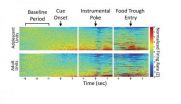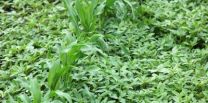(Press-News.org) PITTSBURGH—University of Pittsburgh researchers have recorded neuron activity in adolescent rat brains that could reveal the biological root of the teenage propensity to consider rewards over consequences and explain why adolescents are more vulnerable to drug addiction, behavioral disorders, and other psychological ills.
The team reports in the Journal of Neuroscience that electrode recordings of adult and adolescent brain-cell activity during the performance of a reward-driven task show that adolescent brains react to rewards with far greater excitement than adult brains. This frenzy of stimulation occurred with varying intensity throughout the study along with a greater degree of disorganization in adolescent brains. The brains of adult rats, on the other hand, processed their prizes with a consistent balance of excitation and inhibition.
The extreme difference in brain activity provides a possible physiological explanation as to why teenagers are more prone than adults to rash behavior, addiction, and mental diseases, said lead researcher Bita Moghaddam, a professor of neuroscience in Pitt's School of Arts and Sciences. She and coauthor David Sturman, a Pitt neuroscience doctoral student, observed the disparate reactions to reward in individual neurons in the orbitofrontal cortex, a brain region that weighs payoff and punishment to plan and make decisions.
"The disorganized and excess excitatory activity we saw in this part of the brain means that reward and other stimuli are processed differently by adolescents," Moghaddam said. "This could intensify the effect of reward on decision making and answer several questions regarding adolescent behavior, from their greater susceptibility to substance abuse to their more extreme reactions to pleasurable and upsetting experiences."
In addition, malfunctions in the orbitofrontal cortex have been observed in cases of schizophrenia, mood disorders, and other psychological disturbances, Moghaddam said. The type of erratic activity in the cortex that she and Sturman observed could aggravate these conditions at a time when the maturing brain is vulnerable.
"The symptoms of these illnesses generally begin to appear during adolescence," Moghaddam said. "Adolescence is a period of behavioral and psychiatric vulnerabilities, so the disorganized brain activity and excess excitation could push a brain already predisposed to mental disorders too far, triggering the onset of symptoms."
The study is the first to record and compare individual neuron activity in adult and adolescent brains during the performance of a task. Moghaddam and Sturman presented adult and adolescent rats—which exhibit behavioral and biological similarities to adult and teenage humans—with three holes to poke their noses through; the rats each received a sugar pellet when they chose the center hole.
Brain activity in the adolescents was similar to that of the adults most of the time but striking differences arose when the younger rats retrieved rewards. As each of the adult rats collected a sugar pellet, the orbitofrontal cortex neurons showed the normal increase in both excitation and inhibition, with consistent levels of each impulse throughout the study.
Adolescents, on the other hand, exhibited surges of excitation that ranged from twice to four times the levels in adults. At the same time, the inhibitory impulses in the adolescents' brains barely changed from the low levels they experienced before receiving the sugar pellet.
INFORMATION:
Pitt team finds teen brains over-process rewards, suggesting root of risky behavior, mental ills
The first recordings of individual neurons in adolescent brains during a reward-driven task show that teen brains react with erratic excitement well above adult levels, according to a Journal of Neuroscience report
2011-01-27
ELSE PRESS RELEASES FROM THIS DATE:
Sharing child caregiving may increase parental conflict, study finds
2011-01-27
COLUMBUS, Ohio -- Parents who share caregiving for their preschool children may experience more conflict than those in which the mother is the primary caregiver, according to a new study.
Results showed that couples had a stronger, more supportive co-parenting relationship when the father spent more time playing with their child. But when the father participated more in caregiving, like preparing meals for the child or giving baths, the couples were more likely to display less supportive and more undermining co-parenting behavior toward each other.
The results were ...
Centuries of sailors weren't wrong: Looking at the horizon stabilizes posture
2011-01-27
Everybody who has been aboard a ship has heard the advice: if you feel unsteady, look at the horizon. For a study published in Psychological Science, a journal of the Association for Psychological Science, researchers measured how much people sway on land and at sea and found there's truth in that advice; people aboard a ship are steadier if they fix their eyes on the horizon.
Thomas A. Stoffregen of the University of Minnesota has been studying "body sway" for decades—how much people rock back and forth in different situations, and what this has to do with motion sickness. ...
Low socioeconomic status increases depression risk in rheumatoid arthritis patients
2011-01-27
A recent study confirmed that low socioeconomic status (SES) is associated with higher risk of depressive symptoms in patients with rheumatoid arthritis (RA). Statistically significant differences in race, public versus tertiary-care hospital, disability and medications were found between depressed and non-depressed patients. Study findings are reported in the February issue of Arthritis Care & Research, a journal published by Wiley-Blackwell on behalf of the American College of Rheumatology (ACR).
Roughly 1.3 million Americans are affected by RA—a chronic autoimmune ...
Waterhemp rears its ugly head ... again
2011-01-27
Waterhemp has done it again. University of Illinois researchers just published an article in Pest Management Science confirming that waterhemp is the first weed to evolve resistance to HPPD-inhibiting herbicides.
"A fifth example of resistance in one weed species is overwhelming evidence that resistance to virtually any herbicide used extensively on this species is possible," said Aaron Hager, U of I Extension weed specialist.
Waterhemp is not a weed species that can be adequately managed with one or two different herbicides, Hager said. This troublesome weed requires ...
Agave fuels global excitement as a bioenergy crop
2011-01-27
Scientists found that in 14 independent studies, the yields of two Agave species greatly exceeded the yields of other biofuel feedstocks, such as corn, soybean, sorghum, and wheat. Additionally, even more productive Agave species that have not yet been evaluated exist.
According to bioenergy analyst, Sarah Davis, "We need bioenergy crops that have a low risk of unintended land use change. Biomass from Agave can be harvested as a co-product of tequila production without additional land demands. Also, abandoned Agave plantations in Mexico and Africa that previously supported ...
The undead may influence biodiversity, greenhouse gas emissions
2011-01-27
EAST LANSING, Mich. — It's commonly known, at least among microbiologists, that microbes have an additional option to living or dying — dormancy.
Dormant microbes are less like zombies and more like hibernating bears. What isn't known, however, is how large numbers of dormant microorganisms affect the natural environments when they act as microbial seed banks. In the current issue of Nature Reviews: Microbiology, Jay Lennon, Michigan State University assistant professor of microbiology and molecular genetics, examines the cellular mechanisms that allow microbes to hibernate ...
RIC study suggests researchers are entering a new era of advances in brain research
2011-01-27
CHICAGO (January 26) – Scientists at The Rehabilitation Institute of Chicago (RIC), designated the "#1 Rehabilitation Hospital in America" by U.S. News & World Report since 1991, report that, thanks to improvements in technology and data analysis, our understanding of the functional principles that guide the development and operation of the brain could improve drastically in the next few years. The advances could herald a neuroscientific revolution, much as increasing processor speeds paved the way for the computing revolution of the last half century.
In the February, ...
Stimulating the brain's immune response may provide treatment for Alzheimer's disease
2011-01-27
A new target for the prevention of adverse immune responses identified as factors in the development of Alzheimer's disease (AD) has been discovered by researchers at the University of South Florida's Department of Psychiatry and the Center of Excellence for Aging and Brain Repair.
Their findings are published online in the Journal of Neuroscience (http://www.jneurosci.org/).
The CD45 molecule is a receptor on the surface of the brain's microglia cells, cells that support the brain's neurons and also participate in brain immune responses.
Previous studies by the ...
Membrane molecule keeps nerve impulses hopping
2011-01-27
CHAPEL HILL, N.C. -- New research from the University of North Carolina at Chapel Hill School of Medicine describes a key molecular mechanism in nerve fibers that ensures the rapid conductance of nervous system impulses. The findings appear online Jan. 27, 2011 in the journal Neuron.
Our hard-wired nerve fibers or axons rely on an insulating membrane sheath, the myelin, made up of fatty white matter to accelerate the rate of transmission of electrical impulses from the brain to other parts of the body.
Myelin thus acts to prevent electrical current from leaking or prematurely ...
Discovery of a biochemical basis for broccoli's cancer-fighting ability
2011-01-27
Scientists are reporting discovery of a potential biochemical basis for the apparent cancer-fighting ability of broccoli and its veggie cousins. They found for the first time that certain substances in the vegetables appear to target and block a defective gene associated with cancer. Their report, which could lead to new strategies for preventing and treating cancer, appears in ACS' Journal of Medicinal Chemistry.
Fung-Lung Chung and colleagues showed in previous experiments that substances called isothiocyanates (or ITCs) — found in broccoli, cauliflower, watercress, ...
LAST 30 PRESS RELEASES:
Simple method can enable early detection and prevention of chronic kidney disease
S-species-stimulated deep reconstruction of ultra-homogeneous CuS nanosheets for efficient HMF electrooxidation
Mechanical and corrosion behavior of additively manufactured NiTi shape memory alloys
New discovery rewrites the rules of antigen presentation
Researchers achieve chain-length control of fatty acid biosynthesis in yeast
Water interactions in molecular sieve catalysis: Framework evolution and reaction modulation
Shark biology breakthrough: Study tracks tiger sharks to Maui mating hub
Mysterious iron ‘bar’ discovered in famous nebula
World-first tool reduces harmful engagement with AI-generated explicit images
Learning about public consensus on climate change does little to boost people’s support for action, study shows
Sylvester Cancer Tip Sheet for January 2026
The Global Ocean Ship-Based Hydrographic Investigations Program (GO-SHIP) receives the Ocean Observing Team Award
Elva Escobar Briones selected for The Oceanography Society Mentoring Award
Why a life-threatening sedative is being prescribed more often for seniors
Findings suggest that certain medications for Type 2 diabetes reduce risk of dementia
UC Riverside scientists win 2025 Buchalter Cosmology Prize
SETI Institute opens call for nominations for the 2026 Tarter Award
Novel theranostic model shows curative potential for gastric and pancreatic tumors
How beige fat keeps blood pressure in check
Fossils reveal ‘latitudinal traps’ that increased extinction risk for marine species
Review: The opportunities and risks of AI in mental health research and care
New map reveals features of Antarctic’s ice-covered landscape
Beige fat promotes healthy vascular function and blood pressure in mice
Chronic low-dose pesticide exposure reduces the life span of wild lake fish, China-based study shows
Tiny earthquakes reveal hidden faults under Northern California
Long-term pesticide exposure accelerates aging and shortens lifespan in fish
Professor Tae-Woo Lee's research group develops groundbreaking perovskite display technology demonstrating the highest efficiency and industry-level operational lifetime
The “broker” family helps tidy up the cell
Ecology: Mummified cheetahs discovery gives hope for species’ Arabic reintroduction
Researchers survey the ADHD coaching boom
[Press-News.org] Pitt team finds teen brains over-process rewards, suggesting root of risky behavior, mental illsThe first recordings of individual neurons in adolescent brains during a reward-driven task show that teen brains react with erratic excitement well above adult levels, according to a Journal of Neuroscience report


